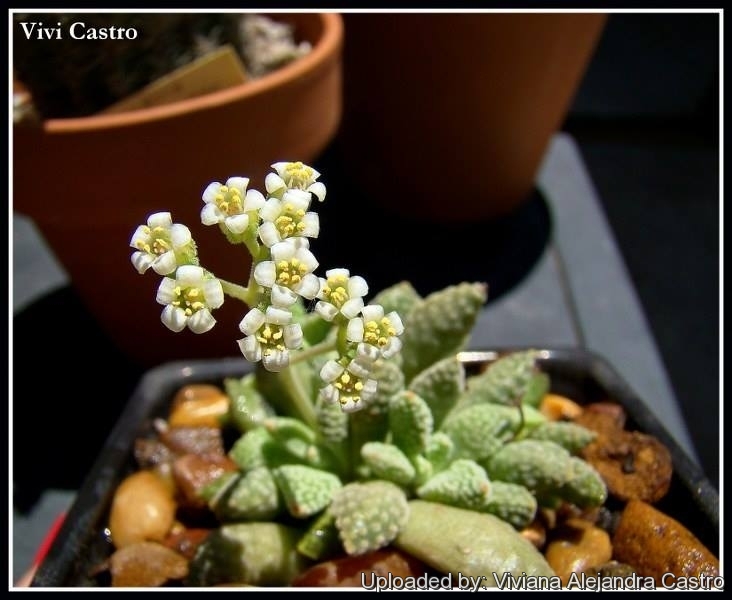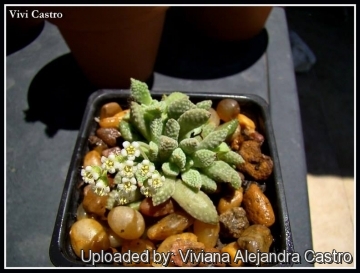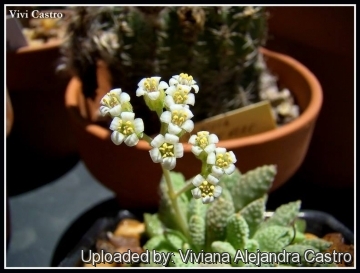
Crassula ausensis subs. titanopsis Photo by: Viviana Alejandra Castro
Origin and Habitat: Crassula ausensisSN|27333]]SN|27333]] ssp titanopsis is a slow grower from Southern Namibia.
Type Locality: Karas: Karasburg District. Hill 25 km W of Gruenau near Signalberg Altitude 1400.
Synonyms:
See all synonyms of Crassula ausensis
Common Names include:
CHINESE (中文): 火星兔子
JAPANESE (日本語): クラッスラ チタノプシス
Description: Crassula ausensisSN|27333]]SN|27333]] subsp. titanopsis is an attractive miniature, perennial, succulent plant distinguished from Crassula ausensisSN|27333]]SN|27333]] subsp. ausensis and Crassula ausensisSN|27333]]SN|27333]] subsp. giessii by its smaller size and forming dense cushions up to 10 cm across. The leaves are clustered in tiny rosettes and are covered with lovely pink, turquoise and brown markings. It produces small white flowers in late autumn and the plant loses a lot of its nice, weird compact look when flowering, but it slowly seems to recover, right before winter, and starts to look good again. In contrast to the other subspecies from a different habitat, subsp. titanopsis grows in summer. Crassula ausensisSN|27333]]SN|27333]] ssp Titanopsis is probably the best looking of all the miniature crassulas and created a bit of a sensation when it was introduced into cultivation in the late 1990s. This is one of those plants best appreciated up close and personal.
Derivation of specific name: Crassula ausensisSN|27333]]SN|27333]] subsp. titanopsis, was named for its resemblance to Titanopsis schwantesiiSN|13458]]SN|13458]] growing in the same habitat.
Stem: Very short, barely rising above ground-level often thick branched suckering.
Leaves: Fascicled and coming right up out of the ground, succulent, warty, elliptic to oblanceolate or spatulate, 12-30 x 4-10 mm, acute, more or less flat above and very much convex below, sometimes triangular in section, greyish-green to turquoise with white or pink papillae and red tips in average light, but will turn much pinker or brown if grown hard.
Inflorescence: Elongate thyrsform to subumbellate, with flowers distinctly pedicellate. Peduncle slender, 20-45 mm long. Sepals triangular, ca.2-3 mm long, bluntly acute. Corolla tubular, fused basally white, lobes oblong, c.4-5 mm long, acute. Stamens yellow with golden-yellow fading brown anthers.
Blooming season: It usually flowers in late autumn / early winter. It start flowering when about 2-4 cm in diameter, still quite small but flowering size, and will flower regularly each year.
Subspecies, varieties, forms and cultivars of plants belonging to the Crassula ausensis group
Bibliography: Major refernces and further lectures
1) Doreen Court “Succulent Flora of Southern Africa” CRC Press, 01/Jun/2000
2) Eggli, Urs “Illustrated Handbook of Succulent Plants, Crassulaceae Illustrated Handbook of Succulent Plants.” Springer, Berlin 2002
3) Dr J.P. Roux “Flora of South Africa” 2003
4) Rowley, G. “Crassula, A grower's guide.” Cactus & Co. libri. 2003
5) James Cullen, Sabina G. Knees, H. Suzanne Cubey "The European Garden Flora Flowering Plants: A Manual for the Identification of Plants Cultivated in Europe, Both Out-of-Doors and Under Glass" Cambridge University Press, 11/Aug/2011
 Crassula ausensis subs. titanopsis Photo by: Viviana Alejandra Castro
Crassula ausensis subs. titanopsis Photo by: Viviana Alejandra Castro Crassula ausensis subs. titanopsis Photo by: Viviana Alejandra Castro
Crassula ausensis subs. titanopsis Photo by: Viviana Alejandra CastroCultivation and Propagation: Crassula ausensisSN|27333]]SN|27333]] subs. titanopsis are of easy cultivation and relatively low maintenance, which makes them a good houseplant (they can grow easily on window sills, verandas and in miniature succulent gardens where they are happy to share their habitat with other smaller succulent plants, or in outdoor rockeries). They are
summer grower (winter dormant).
Soil: They are tolerant of a wide range of soils and habitats, but prefer a very porous potting mix to increase drainage. A non-acid soil is ideal. You can grow a plant in a 6-10 cm pot for years and have perfectly happy plants. For best results, use a shallow pot.
Watering: Provide some water all year around, in the wild most of the growth occurs during summer. During the hot summer months, the soil should be kept moist but not overly wet. During the winter months, water only when the soil becomes completely dry. Wet soil quickly causes root and stem rot, especially during chilly winter months, but can re-root if taken care of. No water should ever be allowed to stand around the roots. Low ambient humidity is always needed.
Fertilization: The plants are fertilized only once during the growing season with a balanced fertilizer diluted to ½ the recommended strength.
Sun Exposure: They need full sun or bright, filtered light with ample airflow to stay compact, but avoid direct blasting sun in mid summer (with sun exposure the leaf develops a nice reddish tint), they do not do well in full shade as they tend to etiolate, fall over and rot easily.
Pest & diseases: Crassulas are sensitive to mealybugs.
Rot: Rot is only a minor problem with Crassula if the plants are watered and “aired” correctly. If they are not, fungicides won't help all that much. Care must be given in watering, keeping them warm and wet while growing, and cooler and dry when dormant.
Hardiness: Although the plants will survive mild frost if kept dry (hardy as low as -5° C) they should be protected from frost to prevent scarring. USDA 9b-12
Use: It is an excellent potted plant great for windowsill culture as well as in rock gardens. Indoors only in brightest position.
Pruning: Remove old leaves from plant base and dead flower spikes only.
Propagation: They are easily propagated by the removal of off shoots, remove a lateral shoot and insert the basal part buried in the soil. This shoot should root within a month, and small offshoots will form at the base. They can also be grown from seed.












